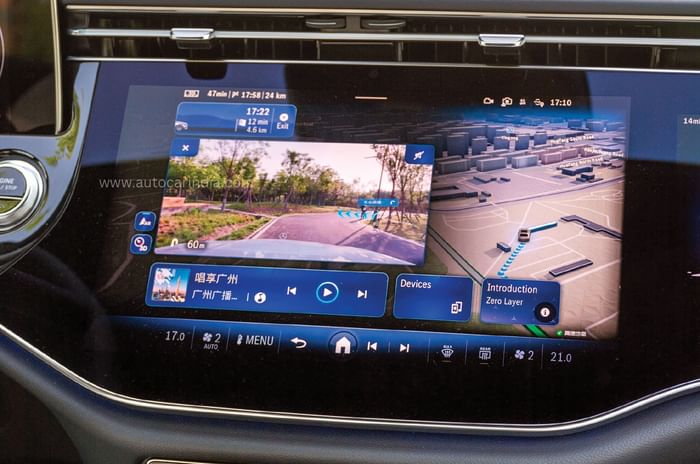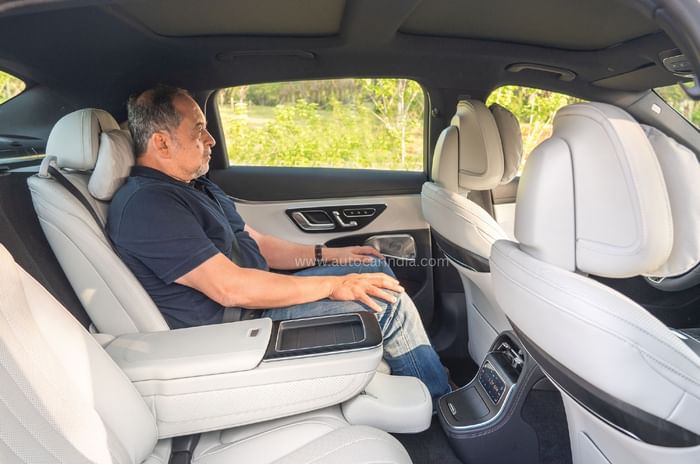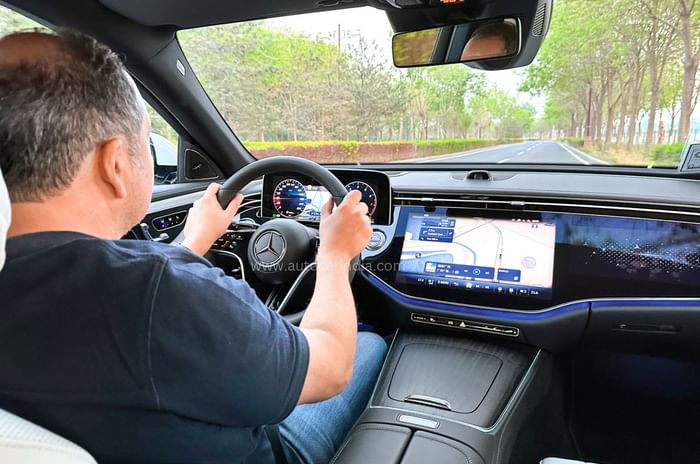At Autocar India, we go to the ends of the Earth to get you the story first. In the past, we’ve been to Brazil, Indonesia, Egypt and half a dozen other countries, all so we can get behind the wheel nice and early. This time, we’ve come to an even more difficult-to-access place: China. And the car that has drawn us here is the all-new long-wheelbase Mercedes E-Class.
Based on the new W214 E-Class, the long-wheelbase E-Class or V214 is a very different car. Substantially longer and heavier, with the focus now on the rear seat, this long-wheelbase car is so different that it could easily be a model unto itself. Core E-Class values, however, remain the same – refinement, comfort and effortless performance. It has always been like this for the E-Class and is likely to remain so long after electrons replace hydrocarbons ‘under the hood’. What’s new is an emphasis on the latest and best digital tech, with many truly impressive solutions implemented on this new car.
For the record, India is the only other market in the world that gets a long-wheelbase E-Class and the only one that gets a right-hand-drive long-wheelbase E-Class. So, is the new V214 better adapted to chauffeur-driven Indian customers? Is it substantially improved in areas that matter? And just how much better are comfort, refinement and performance? Let’s get straight to it.
Extended and Enhanced
First up, the important bits. The new E-Class has even more space between the front and rear axles – 15mm more than the long-wheelbase E currently on sale in India. The new V214’s wheelbase of 3,094mm is also 133mm longer than the standard-wheelbase E‑Class or W214. What’s more, with a wheelbase-to-length ratio of 60.76 percent and rear seats that recline further than before, this new LWB E places an even greater emphasis on comfort.
 Maybach rear doors are shorter, so more manageable. Rear quarter glass stays on body.
Maybach rear doors are shorter, so more manageable. Rear quarter glass stays on body.
It even appears more regal on the outside. The looks clearly are evolutionary, but the version we managed to get our hands on in China had Merc’s traditional ‘radiator’ grille. Similar to the one used on the S-Class, it looks more upmarket and grown up rather than the ‘sportier’ SEC or Avantgarde we get here – the one with the big star in the centre. The grille on this new car protrudes like that of the EQ cars; it gets an LED ring that surrounds it, and what also works well are the angular two-part LED headlights.
Around the side, the shoulder line sweeps to the rear in a long, elegant arc, and the shorter ‘Maybach doors’, with the quarter glass on the C-pillar, are smartly used on the V214 as well. More manageable in tight parking spaces, this door design also delivers a dash of privacy to those seated in the rear.
The new E’s sporty roofline and rounded back are possibly the most attractive parts of the car. A slender bar of chrome sits on top, the organic tail-lights fit neatly below, and what really gets your attention are those three-dimensional Mercedes stars. And there’ll be no misidentifying the E-Class this time around.

While Mercedes doesn’t specifically say how much stiffer the new E-Class body shell is, more stringent crash-test norms in China do point to what is likely to be a stiffer chassis. Boot space, however, is likely to be only sufficient. While the new car gets a 540L boot, a fair amount of that in India will be taken up by the space-saver spare and jack.

Elegance and Emotion
While the exterior is clearly evolutionary, open the front door, and you realise the digital revolution has come to the E-Class. Screens stretch across the dash, and first impressions are of a cabin that’s as high-tech as the Hyperscreen-equipped EQS’. The difference here, though, is that the instrument cluster is on a separate panel. So, this one is called the Superscreen rather than a Hyperscreen. What’s neat is that, as on the S-Class, the 12.3-inch instrument panel can be switched to 3D mode at the touch of a button. Don’t ask how (probably a stereoscopic effect involving some real depth), but the 3D effect works like a charm.

What also sets a very upmarket tone is the gently sloping ‘glass’ dash, with its chrome piping and the almost art deco chrome-like vents that fall away at both ends. There’s also a significant step up in material quality and fit, something you can both feel and perceive. While the current car has sections where quality levels are only ordinary, here, only some plastics that stay out of view feel like they don’t belong. What ups the impression of quality further is the seamless integration of glass, chrome, leather and piano black.
Once you are done gawking, what draws your attention next is the big 14.4-inch central screen. The screen is so good that display quality, speed and ease of use are right up there with the latest Teslas. The screen gets Qualcomm’s new Snapdragon 8295 processor that’s specifically created for automotive applications – the car runs Merc’s latest MBUX 3, and with its floating islands and a zero-layer flat structure, functionality, usability and speed are much better. Even the navigation prompts overlaid on live video on the screen work a treat. MBUX sure has come a long way. There are some niggles, however. Physical climate control buttons have now retreated into a menu. Even worse, getting to the desired menu takes a couple of prods. Then, there are the haptic steering and seat controls that deliver almost no feedback and are fiddly to use. While the car gets two large sunroofs, you miss having one large seamless stretch of sky. Mercedes has provided a string of buttons at the bottom of the centre screen, where you can access drive modes and volume directly, and what’s cool is you can control the vents electrically from the screen.

What also makes the cabin feel more high-tech is a set of new features. For instance, the car gets its own selfie camera (placed on the dash), and you can do Zoom or Webex meetings if the conditions are right. There’s also an app view on the main screen, where the app ‘buttons’ on the screen are made large and easy to hit, à la Apple. Then, if you are alone in the car, you can issue voice commands without saying, ‘Hey Mercedes’. You even have the option of letting AI learn your routine and suggest ‘scenarios’ where it can act on preset conditions, like using presets for temperature. You can also play games on the 12.3-inch passenger screen. Of course, it gets a privacy mode to prevent the driver from being distracted.
In addition, the front of the cabin is decently practical too. Having the gear selector on the steering column leaves the tall centre console free for cup holders, USB ports and storage, and the carpeted door bins are pretty large as well.
Take-it-easy policy
Climb into the rear, and first impressions are of a superior seat and higher-spec cabin with a good amount of legroom. Those wanting more space can use the ‘boss seat’ function and electrically push the front passenger seat forward.

Once settled, the nicely cushioned seats feel plusher, the seat backs are more rounded, and you feel you are seated higher for better comfort. The backrest even reclines further (to 36 rather than 35 degrees on the current car), the soft neck pillow feels great when you sink into the seat, and you can even electrically extend the thigh support by a couple of inches. It’s not a full Pullman seat, so no large support cushion pops up for your calves. There’s no screen on the extended centre section, but you do get extra storage, a secure place to put your phone, and sunblinds at the sides and rear. Headroom is also sufficient, and though this new car feels marginally wider, sitting on the small centre seat – with the rear climate control popping out – is still only workable for short drives.

The new E now gets four-zone climate control, and the blower at the rear works in a relatively more silent manner. Just how much more effective this aircon system is in the back compared to the current car (which isn’t great on a hot day) will best be tested in our hotter ambient conditions. Also, there’s only one cup holder. However, you do get wireless chargers, and this car gets cooled rear seats.
On a cruise
Climbing in behind the wheel of the E-Class for the first time, I’m flooded with memories and mental images of earlier E-Classes. Will this new high-tech-looking spaceship really feel like an E-Class from behind the wheel? The refinement, the hush in the cabin, the supple ride, the agile and effortless performance? Must say, the seat feels just as welcoming and comfortable but with a touch more side support. Merc’s big steering wheel, with its piano black spokes, also suits this car more than the sporty AMG one.

On the move, initial impressions are of a car that rides very comfortably. Most roads in Beijing are well paved, but out towards the suburbs, road surfaces tend to get more varied, with the occasional bad patches and broken sections popping up. And it’s here that the E-Class shines. There’s a suppleness to the suspension that isolates the cabin from the road really well, and this new E-Class also rides flat, with very little noticeable pitching and bobbing. However, the springs aren’t marshmallow-soft, and at low speeds, you do get a hint of stiffness over horizontal ridges and large bumps. Do note that the car in India will be raised (Merc calls it the rough-road package), and this could change things. The cabin is also quieter than the current E. Merc claims to have done a lot of extra isolation and sound absorption work here, and both road noise and wind noise are well-damped; the hush when you close the world outside is also more palpable.
The new E also feels more agile and lighter on its feet. The steering needs less effort at low speeds; the five-metre-long car feels more willing to turn, and what’s nice is that the steering even weighs up progressively as you go faster, with a fair amount of feel and connect coming through to your hands. It’s even more agile around corners, as the front and rear suspension work together better in unison. Please remember, though, that it still is a long car and won’t dart into corners or encourage you to drive fast.

The straight-line stability, with the long wheelbase, is very good, and this helps you relax on long drives. The brakes are well-calibrated and have good stopping power, but a bit more initial bite would be nice.
The E300L, with its four-cylinder engine and 400Nm of torque, also feels effortless to get off the line. Peak torque comes in low at 2,000rpm, and what’s nice is that even the buildup from, say, 1,500rpm is strong due to the extra E-boost from the Integrated Starter Generator. Press down harder, and there’s even more grunt, especially with the more powerful 258hp engine making its presence felt after 2,500rpm. Stay on the gas past 4,000rpm, and the E-Class continues to pull hard, the power delivery belying the fact that it’s merely a 2.0-litre engine. It feels quick, too, with 0-100kph coming up in a claimed 6.6 seconds. Rev the engine hard, past 5,000rpm, and it feels strained and reveals its humble four-cylinder origins. This clearly is no creamy Merc straight six, and it shows. While the gearbox is mostly smooth and free from hesitation at low speeds, it does seem to take its time when you are in a hurry.
First impression
 There’s a taut elegance to the four-door coupe-like rear.
There’s a taut elegance to the four-door coupe-like rear.
The new long-wheelbase E-Class headed to India later this year is clearly improved in almost all areas. It isn’t perfect. The evolved looks are fairly safe and don’t really stand out or grab your attention. The boot space is likely to remain compromised due to the insertion of a spare tyre. And if you want more power, punch and refinement, you will have to upgrade to one of Merc’s creamy-smooth straight sixes. You’ll also have to part a vast sum of money, with the expected starting price going north of Rs 85 lakh. But importantly, it’s a noticeable step forward from what was already an excellent starting point. It’s more comfortable and better built on the inside, material quality is superior, it rides better, steers better and drives better, and is also more silent on the inside. The new E, however, isn’t just a more accomplished and updated version of itself. It’s more. A car loaded to the gills with the latest digital tech and cool features. It’s a car that can take on even the best EVs at the tech game and win. So, if you’re looking for the most comfortable, luxurious and elegant sedan in this class, look no further than Merc’s new baby S-Class, the new long-wheelbase E.
2024 Mercedes E-Class LWB: How different is it?

The long-wheelbase E-Class (V214) isn’t just longer and heavier than the regular W214; it’s also different in many important areas. To begin with, the additional weight puts more load on the engine, the gear ratios or final drive need to be altered on some versions to allow for optimum performance and economy, and the car needs a longer propeller shaft. The extra length also means a whole new body section has to be added without losing out on stiffness – the rear door is new. Then the suspension has to be re-calibrated for the new geometry and the entire rear section with its reclining seat is new. Hence, engineers say the V214 is practically an all-new car, one that’s significantly closer to the S-Class than many realise.















































